TOYOTA PRIUS C 2016 NHP10 / 1.G Quick Reference Guide
Manufacturer: TOYOTA, Model Year: 2016, Model line: PRIUS C, Model: TOYOTA PRIUS C 2016 NHP10 / 1.GPages: 48, PDF Size: 1.49 MB
Page 21 of 48
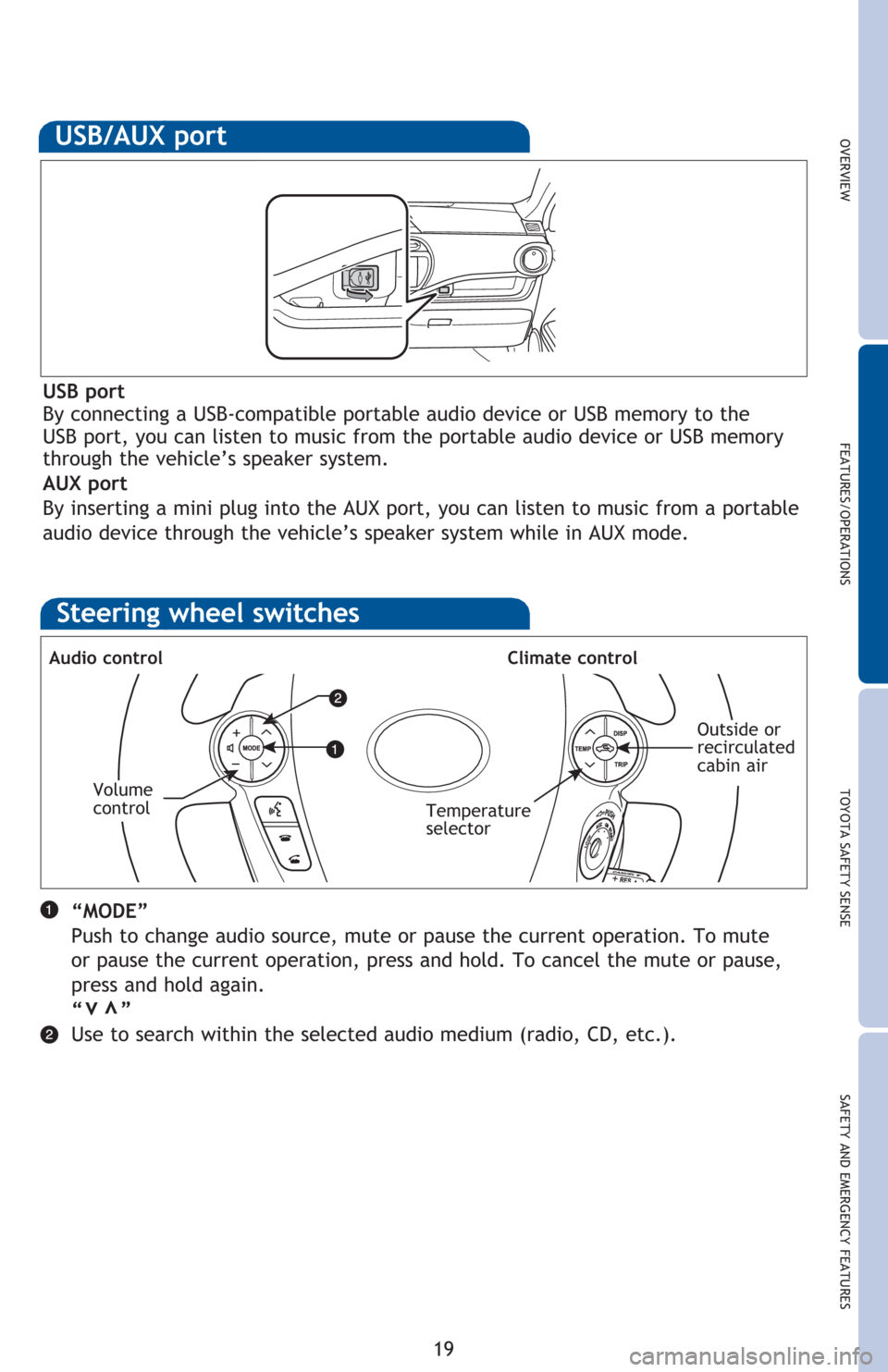
OVERVIEW FEATURES/OPERATIONS TOYOTA SAFETY SENSE SAFETY AND EMERGENCY FEATURES
19
Steering wheel switches
Audio controlClimate control
“MODE”
Push to change audio source, mute or pause the current operation. To mute
or pause the current operation, press and hold. To cancel the mute or pause,
press and hold again.
“
vv”
Use to search within the selected audio medium (radio, CD, etc.).
Volume
controlTemperature
selector
Outside or
recirculated
cabin air
USB/AUX port
USB port
By connecting a USB-compatible portable audio device or USB memory to the
USB port, you can listen to music from the portable audio device or USB memory
through the vehicle’s speaker system.
AUX port
By inserting a mini plug into the AUX port, you can listen to music from a portable
audio device through the vehicle’s speaker system while in AUX mode.
Page 22 of 48

20
Cruise control (if equipped)
1 The set speed may also be cancelled by depressing the brake pedal.2 The set speed may be resumed once vehicle speed exceeds 25 mph.
Turning system ON/OFF
Functions
System ON/OFF
Increase speed
Decrease speed
Cancel1
Resume2
Set
FEATURES/OPERATIONS
Parking brake
Set Release
Pull(2) Push(1) Pull slightly
(3) Lower
Page 23 of 48
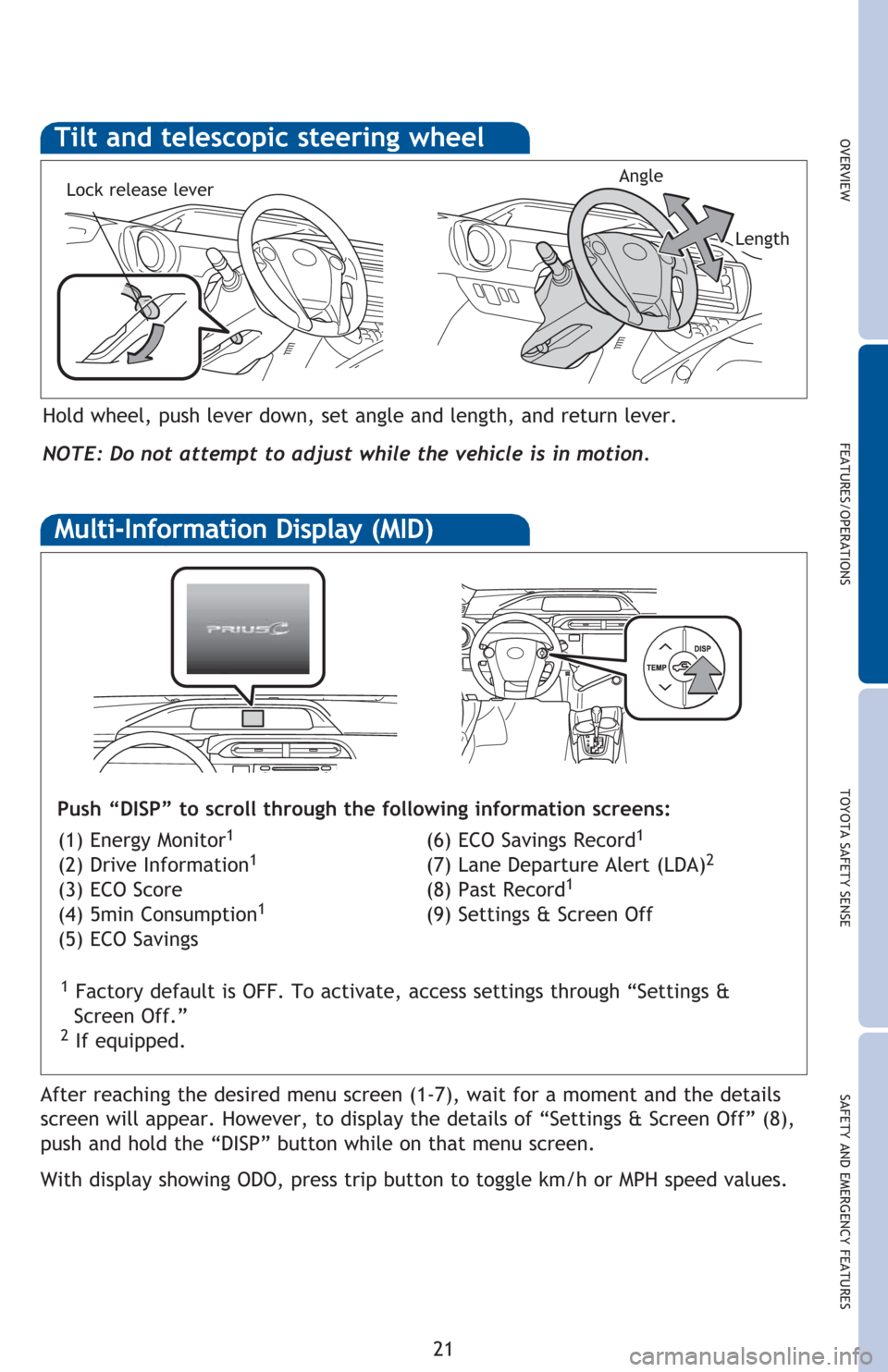
OVERVIEW FEATURES/OPERATIONS TOYOTA SAFETY SENSE SAFETY AND EMERGENCY FEATURES
21
Hold wheel, push lever down, set angle and length, and return lever.
NOTE: Do not attempt to adjust while the vehicle is in motion.
Tilt and telescopic steering wheel
Angle
Length
Lock release lever
Multi-Information Display (MID)
(1) Energy Monitor1
(2) Drive Information1
(3) ECO Score
(4) 5min Consumption1
(5) ECO Savings(6) ECO Savings Record
1
(7) Lane Departure Alert (LDA)2
(8) Past Record1
(9) Settings & Screen Off Push “DISP” to scroll through the following information screens:
After reaching the desired menu screen (1-7), wait for a moment and the details
screen will appear. However, to display the details of “Settings & Screen Off” (8),
push and hold the “DISP” button while on that menu screen.
With display showing ODO, press trip button to toggle km/h or MPH speed values.
1 Factory default is OFF. To activate, access settings through “Settings &
Screen Off.”
2 If equipped.
Page 24 of 48

22
FEATURES/OPERATIONS
Clock
Refer to the Owner’s Manual for details on adjusting time.
Bluetooth® technology allows dialing or receipt of calls without taking hands from
the steering wheel or using a cable to connect the telephone and the system.
Refer to “Bluetooth
® Device Pairing Section,” in this guide, for more information
about phone connections and compatibility.
Microphone (Type A, with moon roof)
Audio unitSteering wheel telephone switches
Volume
Start call
End call
Microphone (Type B, without moon roof)
Telephone controls (Bluetooth®)
Page 25 of 48
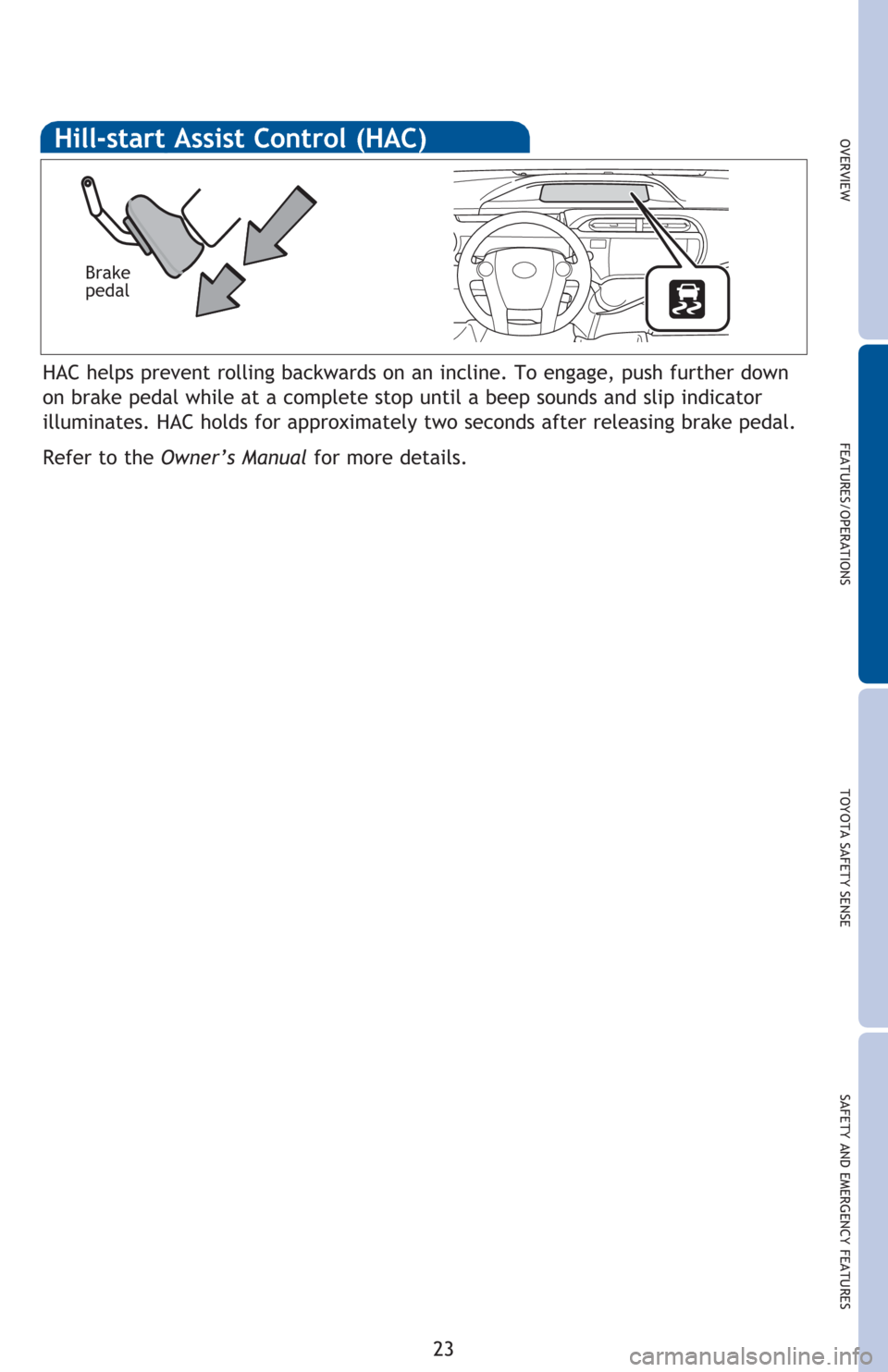
OVERVIEW FEATURES/OPERATIONS TOYOTA SAFETY SENSE SAFETY AND EMERGENCY FEATURES
23
HAC helps prevent rolling backwards on an incline. To engage, push further down
on brake pedal while at a complete stop until a beep sounds and slip indicator
illuminates. HAC holds for approximately two seconds after releasing brake pedal.
Refer to the Owner’s Manual for more details.
Brake
pedal
Hill-start Assist Control (HAC)
Page 26 of 48
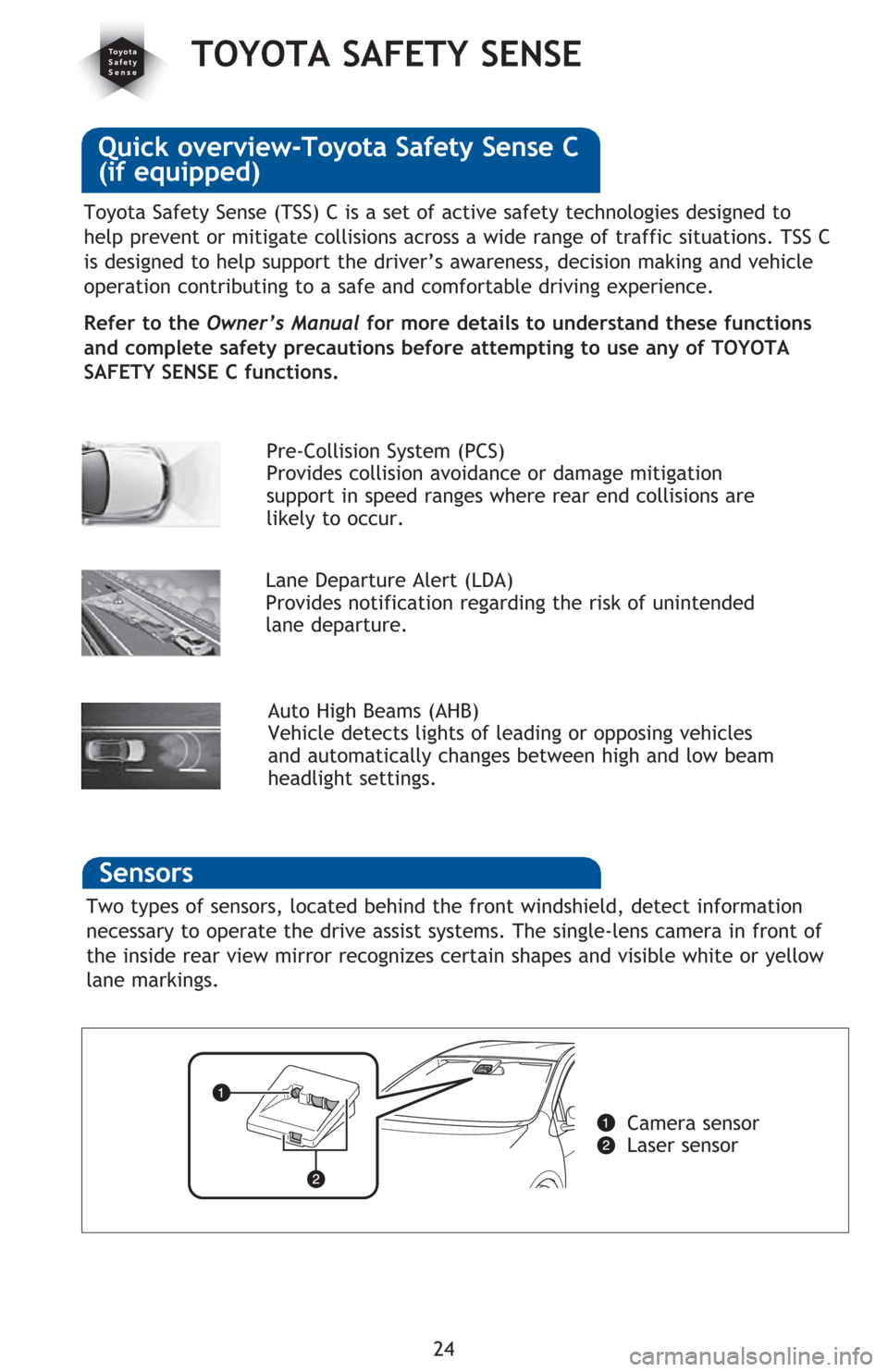
24
Quick overview-Toyota Safety Sense C
(if equipped)
TOYOTA SAFETY SENSE
Pre-Collision System (PCS)
Provides collision avoidance or damage mitigation
support in speed ranges where rear end collisions are
likely to occur.
Lane Departure Alert (LDA)
Provides notification regarding the risk of unintended
lane departure.
Auto High Beams (AHB)
Vehicle detects lights of leading or opposing vehicles
and automatically changes between high and low beam
headlight settings.
Toyota Safety Sense (TSS) C is a set of active safety technologies designed to
help prevent or mitigate collisions across a wide range of traffic situations. TSS C
is designed to help support the driver’s awareness, decision making and vehicle
operation contributing to a safe and comfortable driving experience.
Refer to the Owner’s Manual for more details to understand these functions
and complete safety precautions before attempting to use any of TOYOTA
SAFETY SENSE C functions.
Sensors
Two types of sensors, located behind the front windshield, detect information
necessary to operate the drive assist systems. The single-lens camera in front of
the inside rear view mirror recognizes certain shapes and visible white or yellow
lane markings.
Camera sensor
Laser sensor
Page 27 of 48
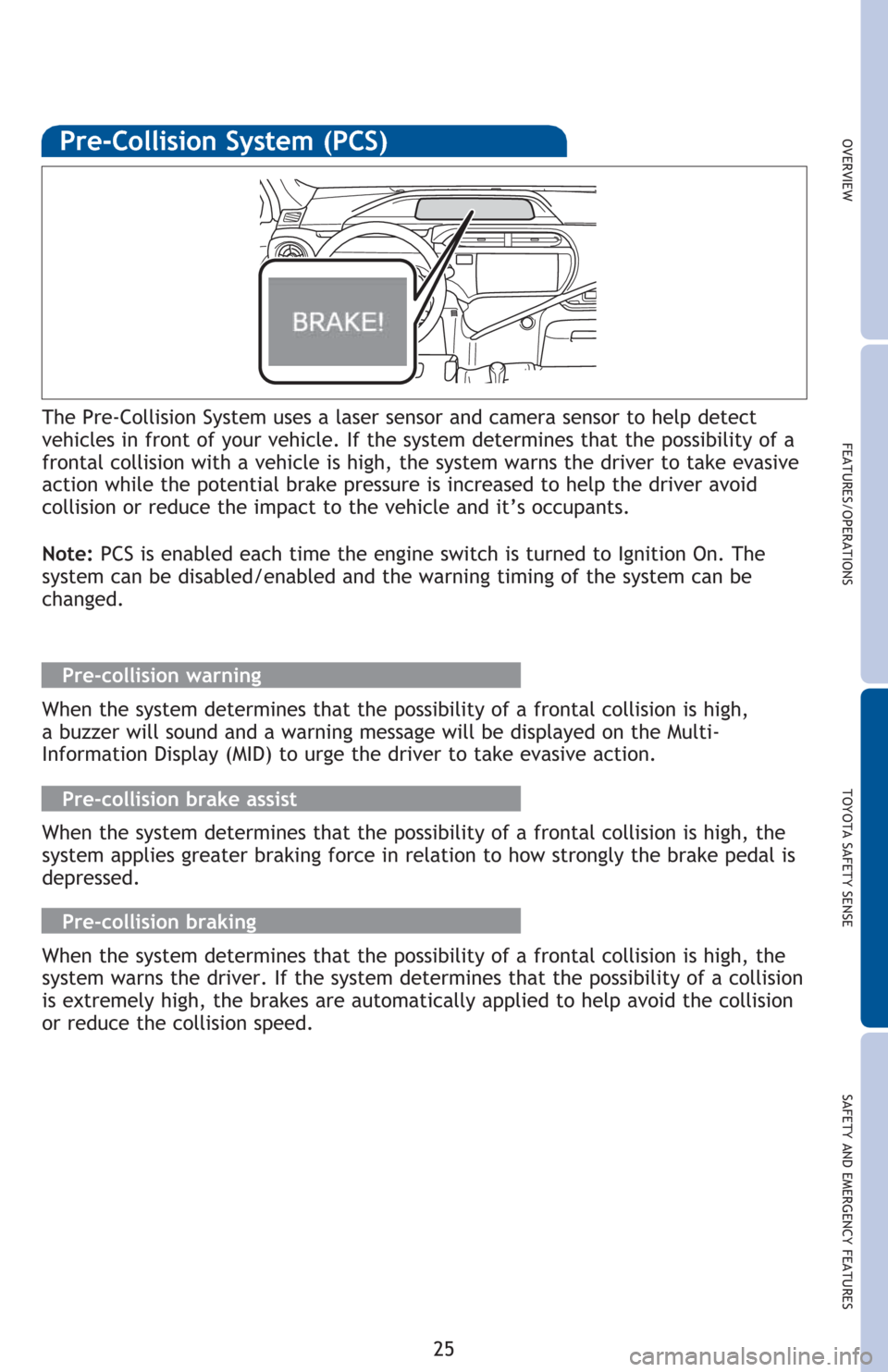
25
OVERVIEW FEATURES/OPERATIONS TOYOTA SAFETY SENSE SAFETY AND EMERGENCY FEATURES
Pre-Collision System (PCS)
The Pre-Collision System uses a laser sensor and camera sensor to help detect
vehicles in front of your vehicle. If the system determines that the possibility of a
frontal collision with a vehicle is high, the system warns the driver to take evasive
action while the potential brake pressure is increased to help the driver avoid
collision or reduce the impact to the vehicle and it’s occupants.
Note: PCS is enabled each time the engine switch is turned to Ignition On. The
system can be disabled/enabled and the warning timing of the system can be
changed.
Pre-collision warning
When the system determines that the possibility of a frontal collision is high,
a buzzer will sound and a warning message will be displayed on the Multi-
Information Display (MID) to urge the driver to take evasive action.
Pre-collision brake assist
When the system determines that the possibility of a frontal collision is high, the
system applies greater braking force in relation to how strongly the brake pedal is
depressed.
Pre-collision braking
When the system determines that the possibility of a frontal collision is high, the
system warns the driver. If the system determines that the possibility of a collision
is extremely high, the brakes are automatically applied to help avoid the collision
or reduce the collision speed.
Page 28 of 48
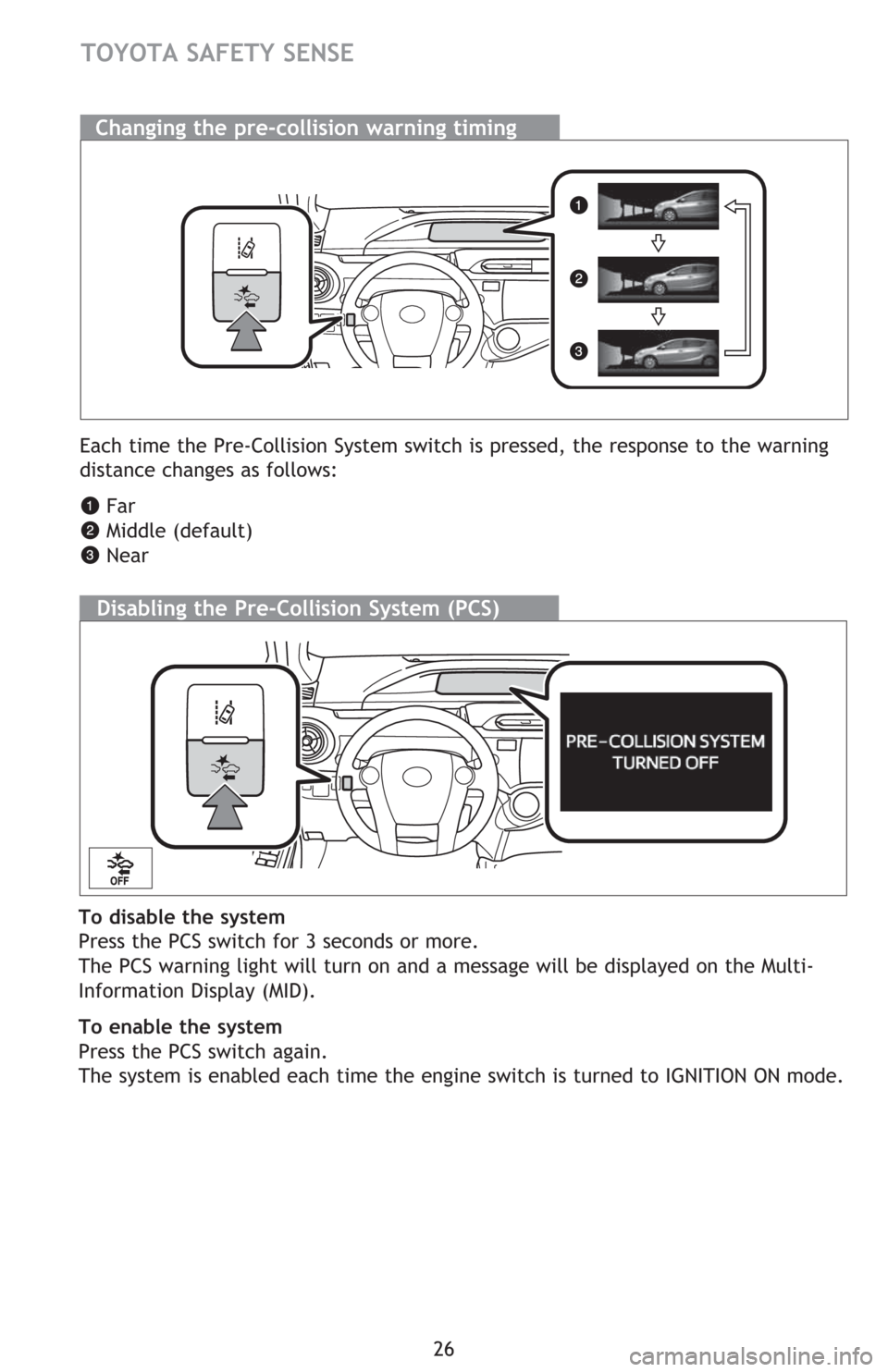
26
Changing the pre-collision warning timing
Disabling the Pre-Collision System (PCS)
Each time the Pre-Collision System switch is pressed, the response to the warning
distance changes as follows:
Far
Middle (default)
Near
To disable the system
Press the PCS switch for 3 seconds or more.
The PCS warning light will turn on and a message will be displayed on the Multi-
Information Display (MID).
To enable the system
Press the PCS switch again.
The system is enabled each time the engine switch is turned to IGNITION ON mode.
TOYOTA SAFETY SENSE
Page 29 of 48
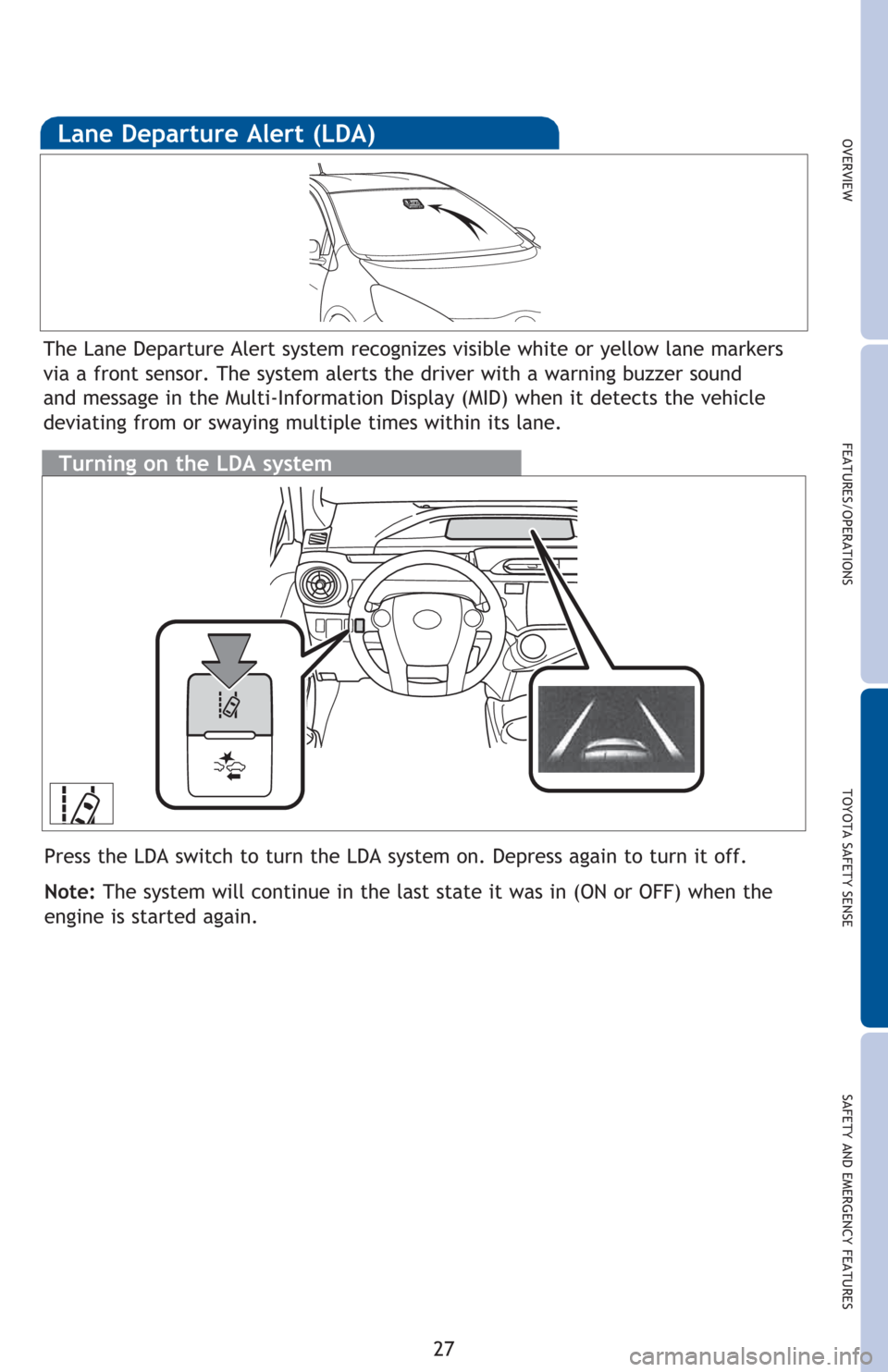
27
OVERVIEW FEATURES/OPERATIONS TOYOTA SAFETY SENSE SAFETY AND EMERGENCY FEATURES
Press the LDA switch to turn the LDA system on. Depress again to turn it off.
Note: The system will continue in the last state it was in (ON or OFF) when the
engine is started again.
The Lane Departure Alert system recognizes visible white or yellow lane markers
via a front sensor. The system alerts the driver with a warning buzzer sound
and message in the Multi-Information Display (MID) when it detects the vehicle
deviating from or swaying multiple times within its lane.
Lane Departure Alert (LDA)
Turning on the LDA system
Page 30 of 48
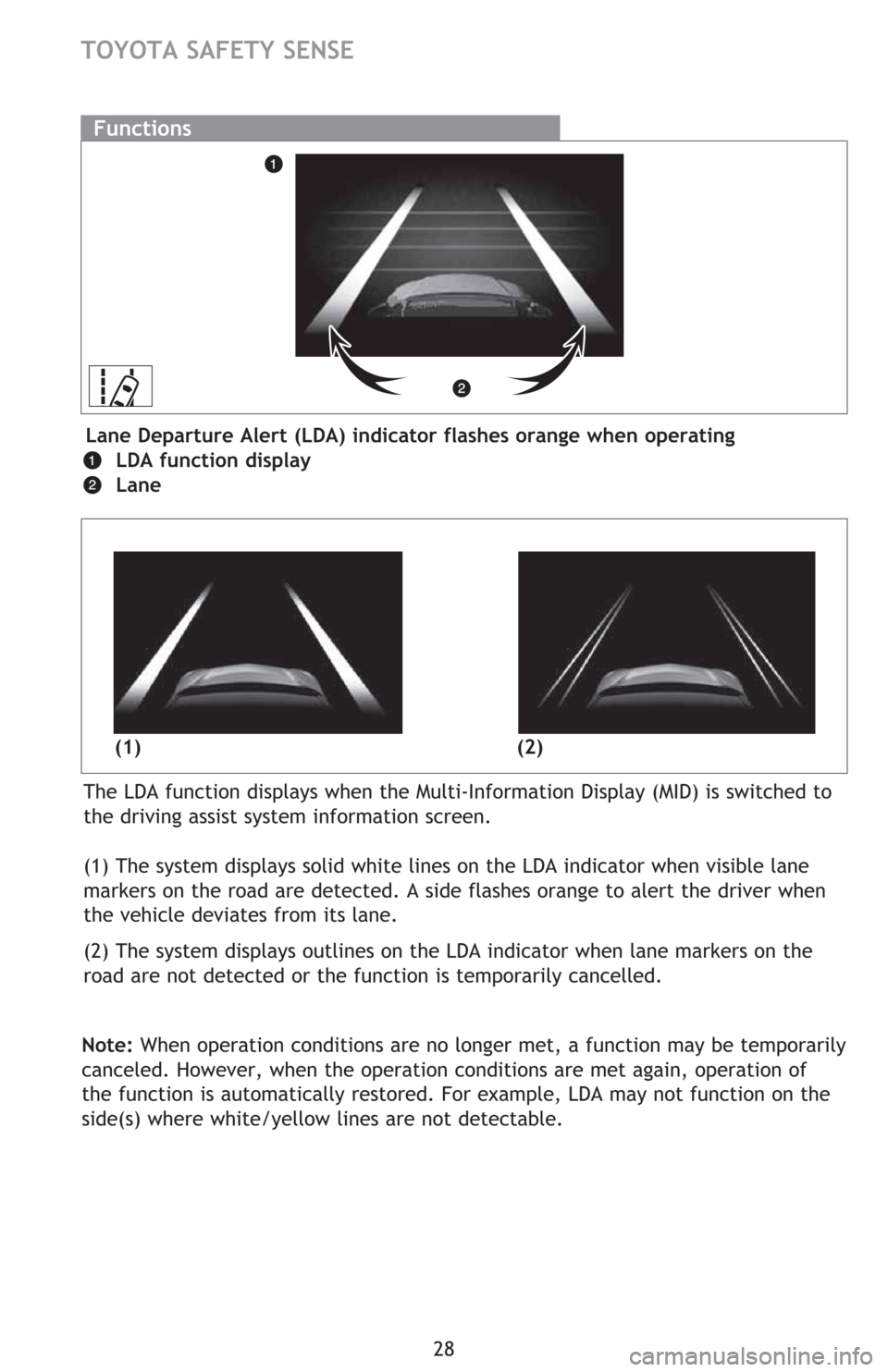
28
The LDA function displays when the Multi-Information Display (MID) is switched to
the driving assist system information screen.
(1) The system displays solid white lines on the LDA indicator when visible lane
markers on the road are detected. A side flashes orange to alert the driver when
the vehicle deviates from its lane.
(2) The system displays outlines on the LDA indicator when lane markers on the
road are not detected or the function is temporarily cancelled.(2)
Note: When operation conditions are no longer met, a function may be temporarily
canceled. However, when the operation conditions are met again, operation of
the function is automatically restored. For example, LDA may not function on the
side(s) where white/yellow lines are not detectable.
Functions
(1) Lane Departure Alert (LDA) indicator flashes orange when operating
LDA function display
Lane
TOYOTA SAFETY SENSE